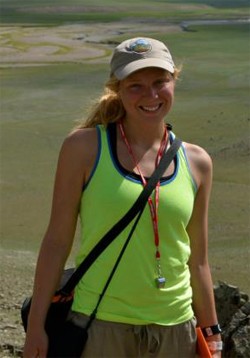Tara Forstner

B.Sc. (Honours) Thesis
Bedrock Incision and Relief Generation of the Western Hangay Mountains, Mongolia
(PDF - 5.2 Mb)
The origin of relief of the Hangay Mountains in west-central Mongolia is problematic because they are situated far from any plate boundary or major active tectonic structure. Straths, former stream bottoms preserved as bedrocks terraces, are useful indicators of rock uplift or foreland basin subsidence. By correlating and dating straths of differing heights preserved along valleys in the western Hangay Mountains, it is possible to relate this to the tectonic or isostatic processes that contribute to the relief. Different methods were used to correlate 365 straths in 3 fourth-order stream valleys in western Hangay Mountains (Chigestei, Bogdiin, and Yaruu rivers). The straths were mapped in the field or identified from Geoogle Earth®, and from slope- and surface-area-constrained querying of ASTER DEM data. No significant downstream convergence or divergence of the paleo-long profiles was apparent from either of the valleys. The strath distribution in all three valleys could be explained by slight divergence or convergence, although the strath correlations for the Yaruu valley favour slight a divergent pattern. The distribution of strath points on an elevation vs. valley distance plot for all three valleys is wider (more elevation) downstream, implying that all three valleys have undergone some divergence. The observation that the correlations and the distribution pattern do not record a steep convergence or divergence indicates that the basin or mountains are rising or falling together, and suggests that the incision has not been accelerated by rapid rock uplift of the upper catchment or rapid base level fall in the past few million years. Cosmogenic 10Be ages on strath terraces in the Chigestei and Bogdiin valleys were adjusted by an erosion rate (3.9 mm/yr) that is calculated by assuming that the highest 10Be concentration is saturated and controlled by surface erosion. The ages range from 35.8±1 to 164±4 years. Because it is likely that the straths were eroded (geometry of the surfaces, lack of stream gravels on straths) and unlikely that the erosion rates were the same, these ages provide only estimates of the time they were abandoned. The calculated incision rates are very low (0 – 0.007 mm/yr). This slow incision rate supports the inference of slow incision based on the interpretation of strath patterns, and implies that there as has not been significant relief generation in the past 0.3 Ma and probably over the last several million years.
Keywords:
Pages: 74
Supervisor: John Gosse



